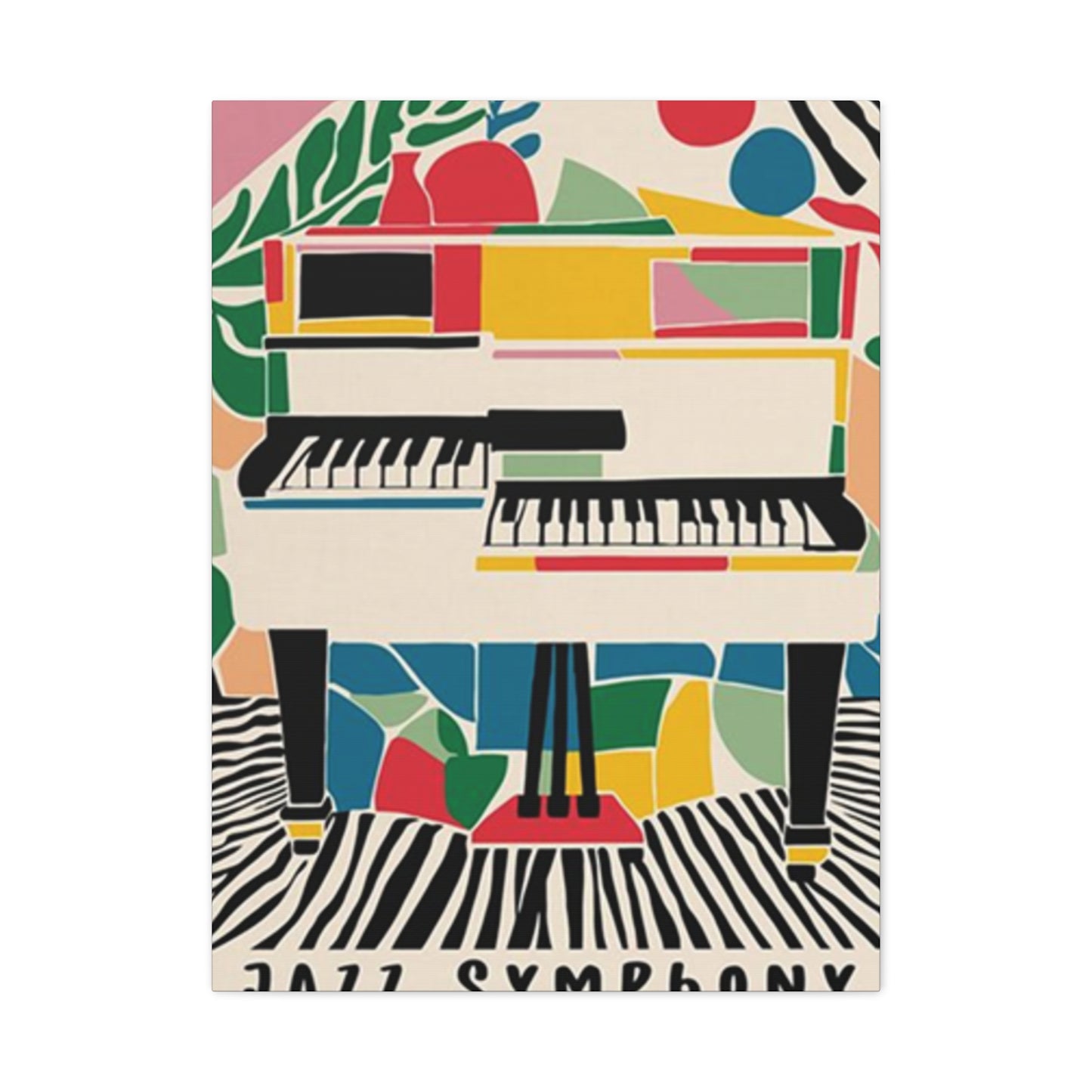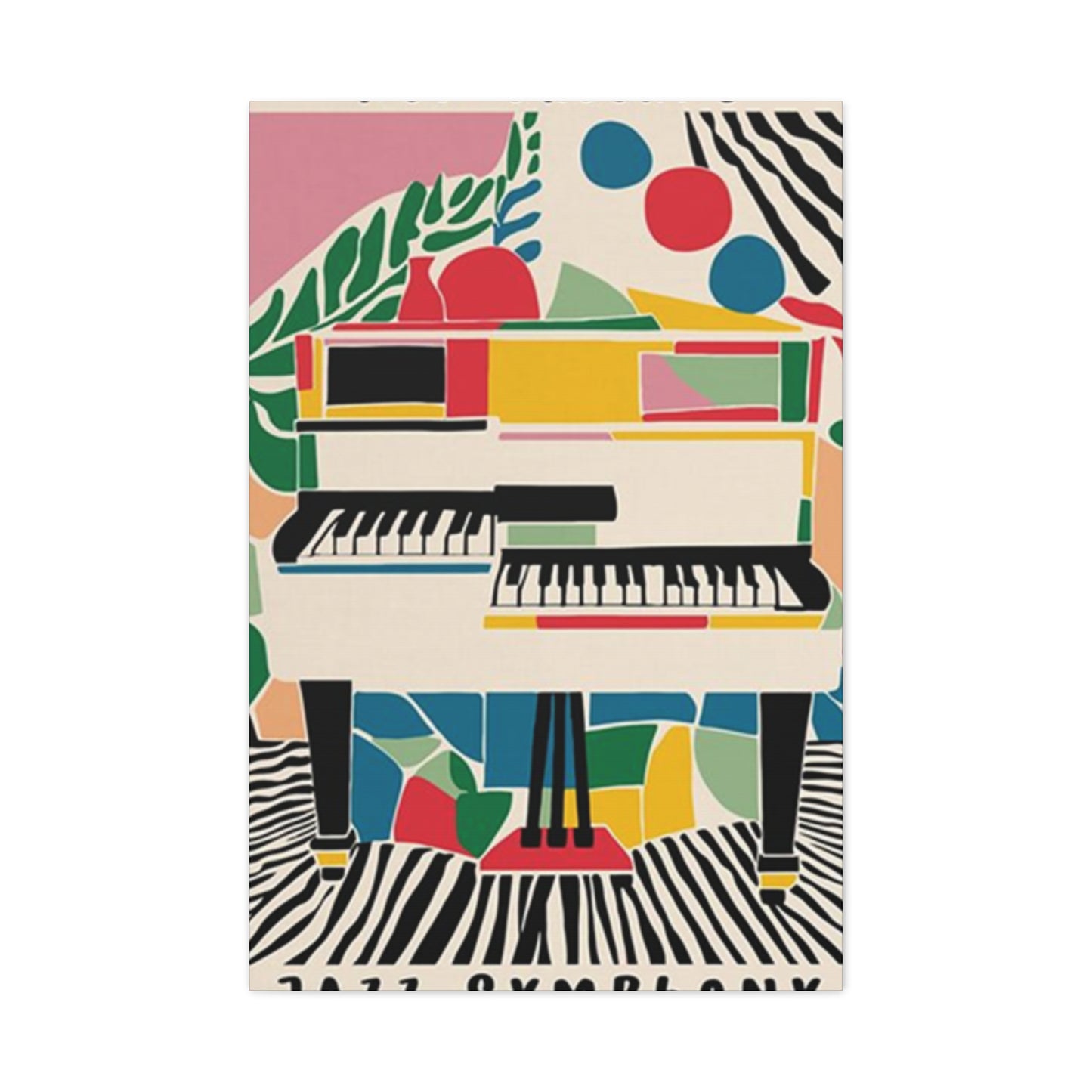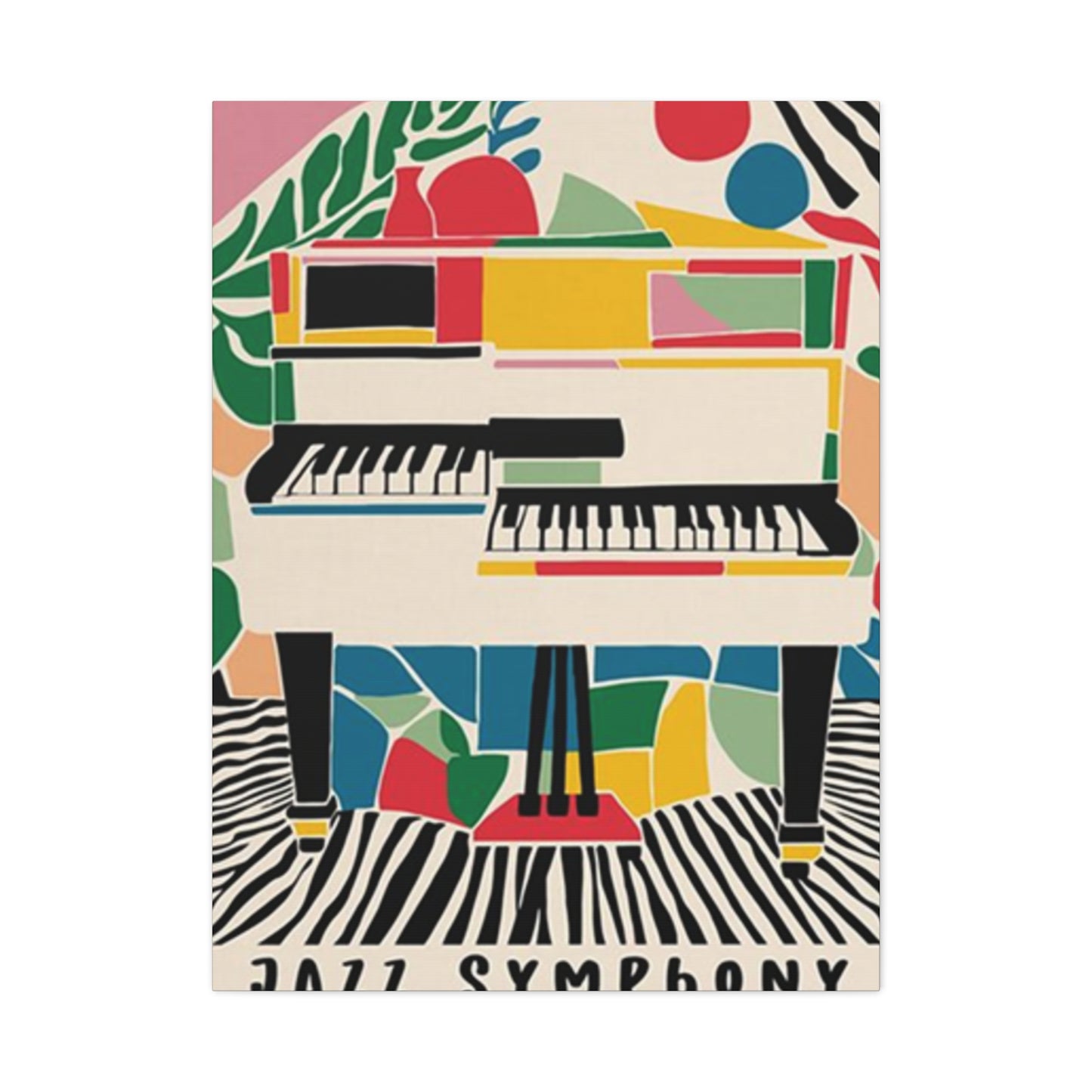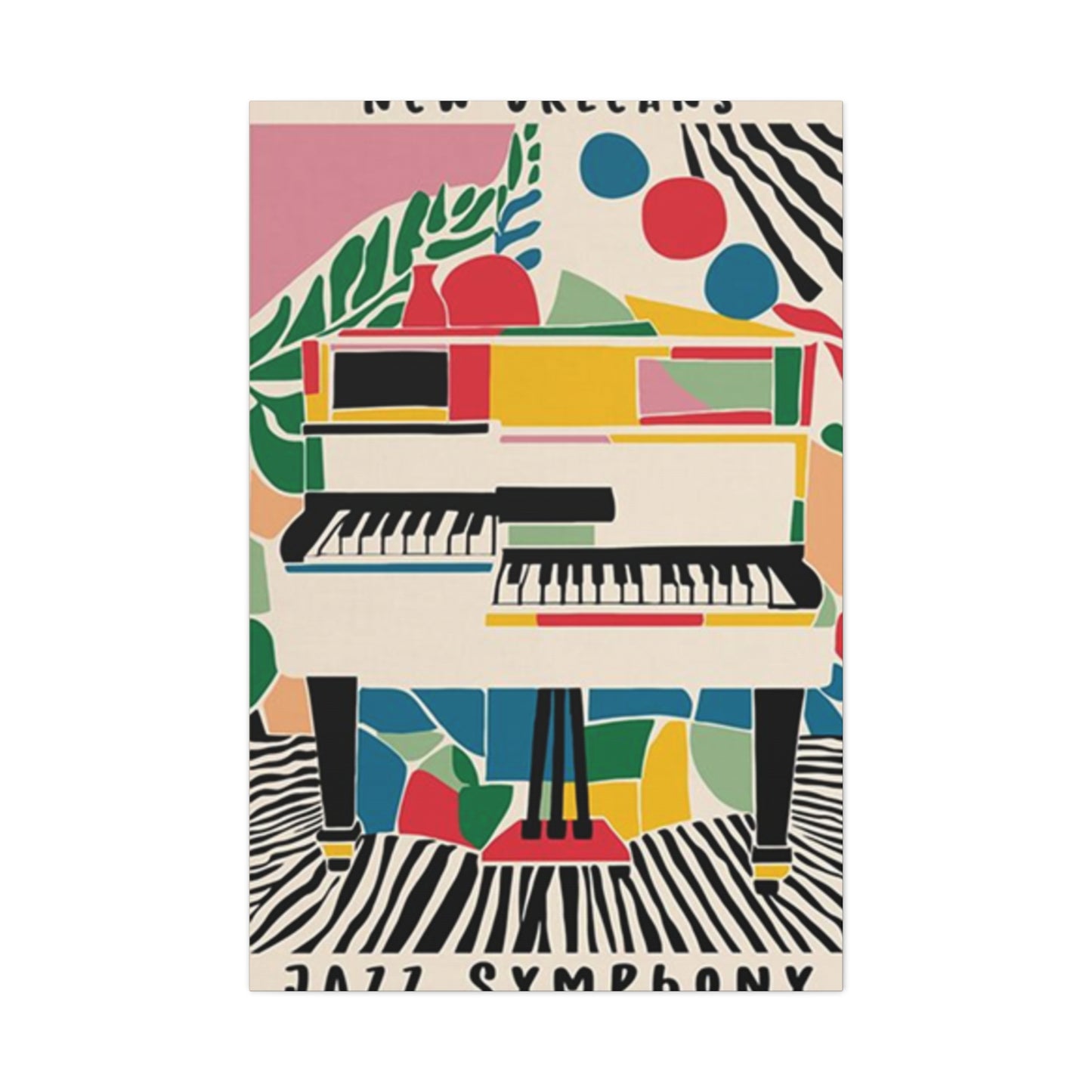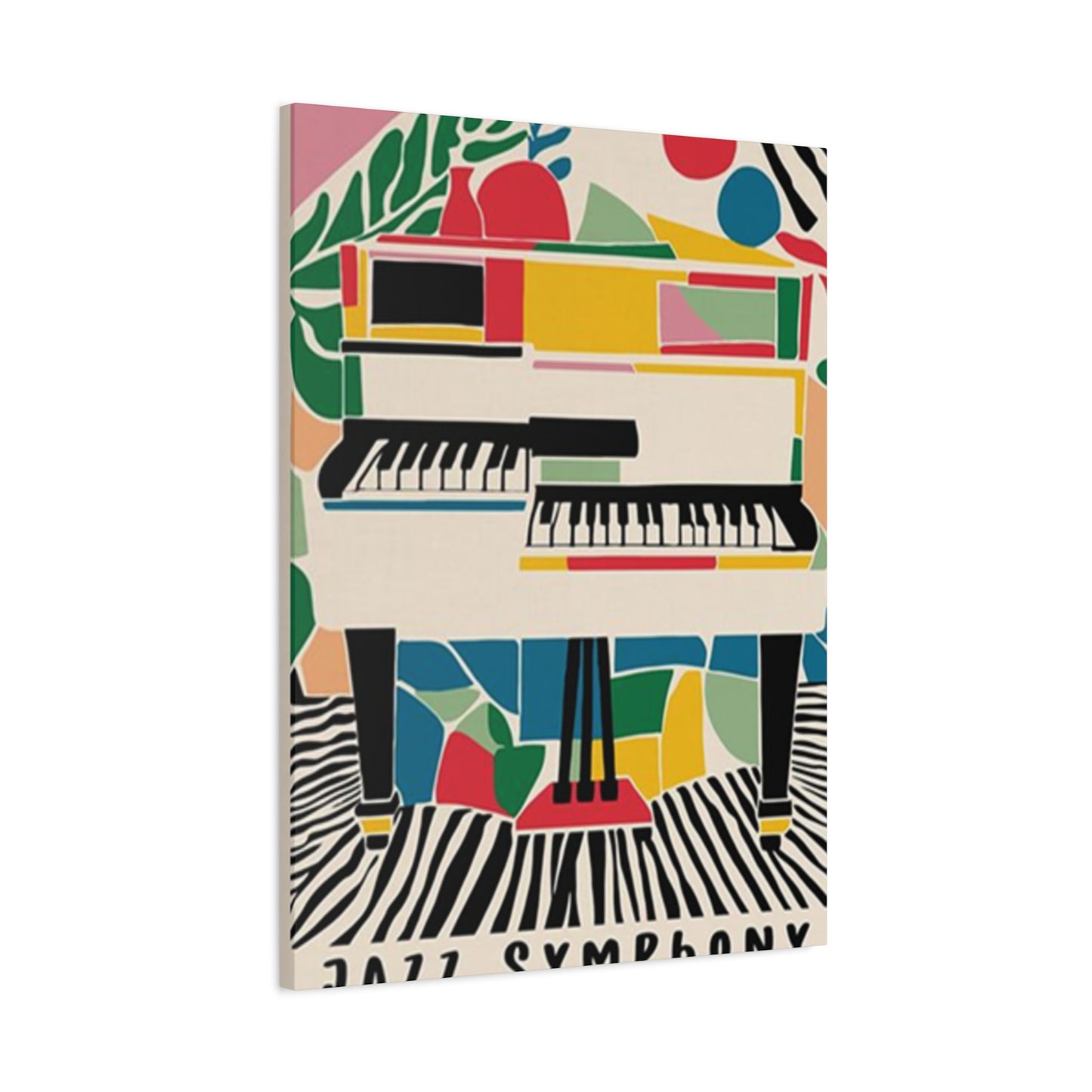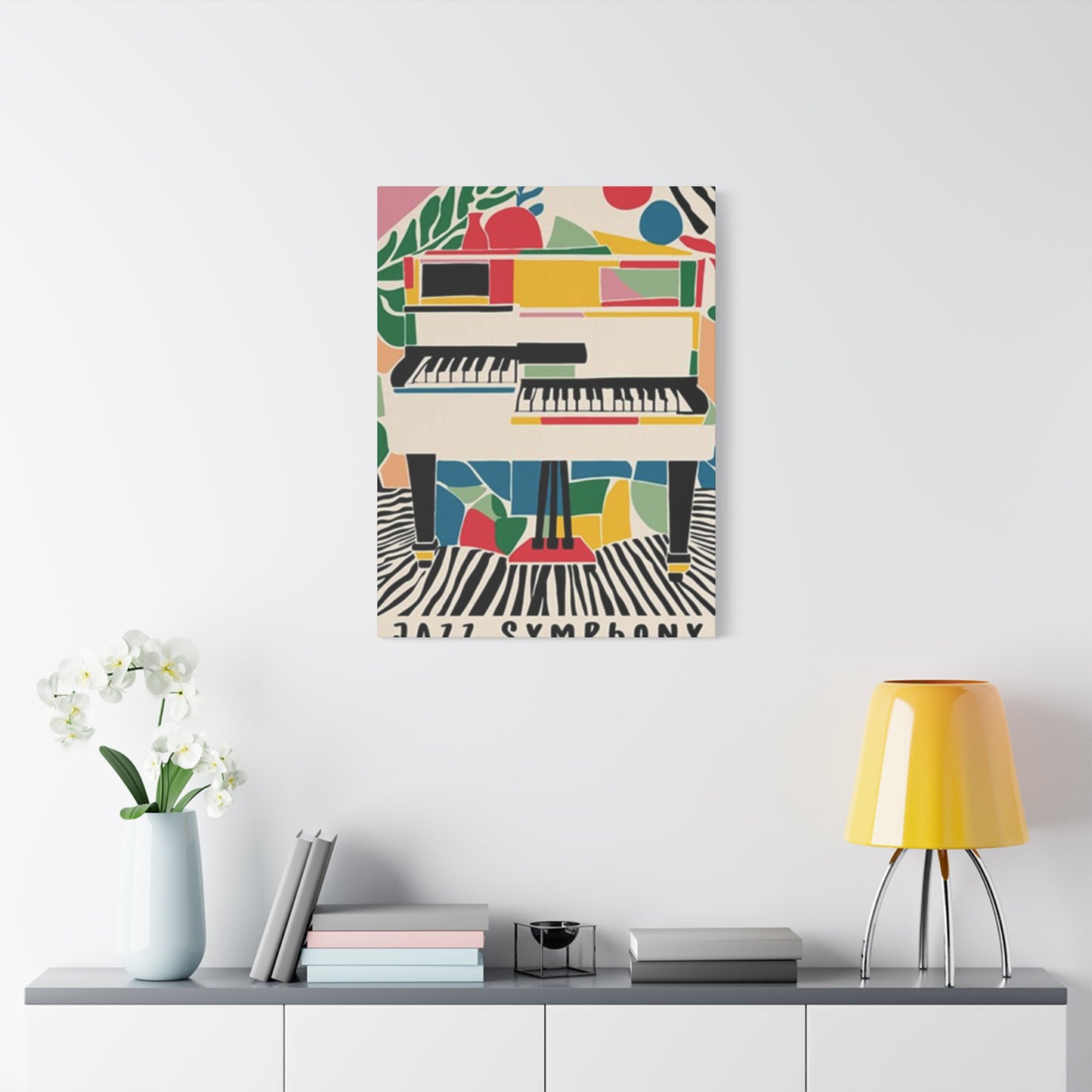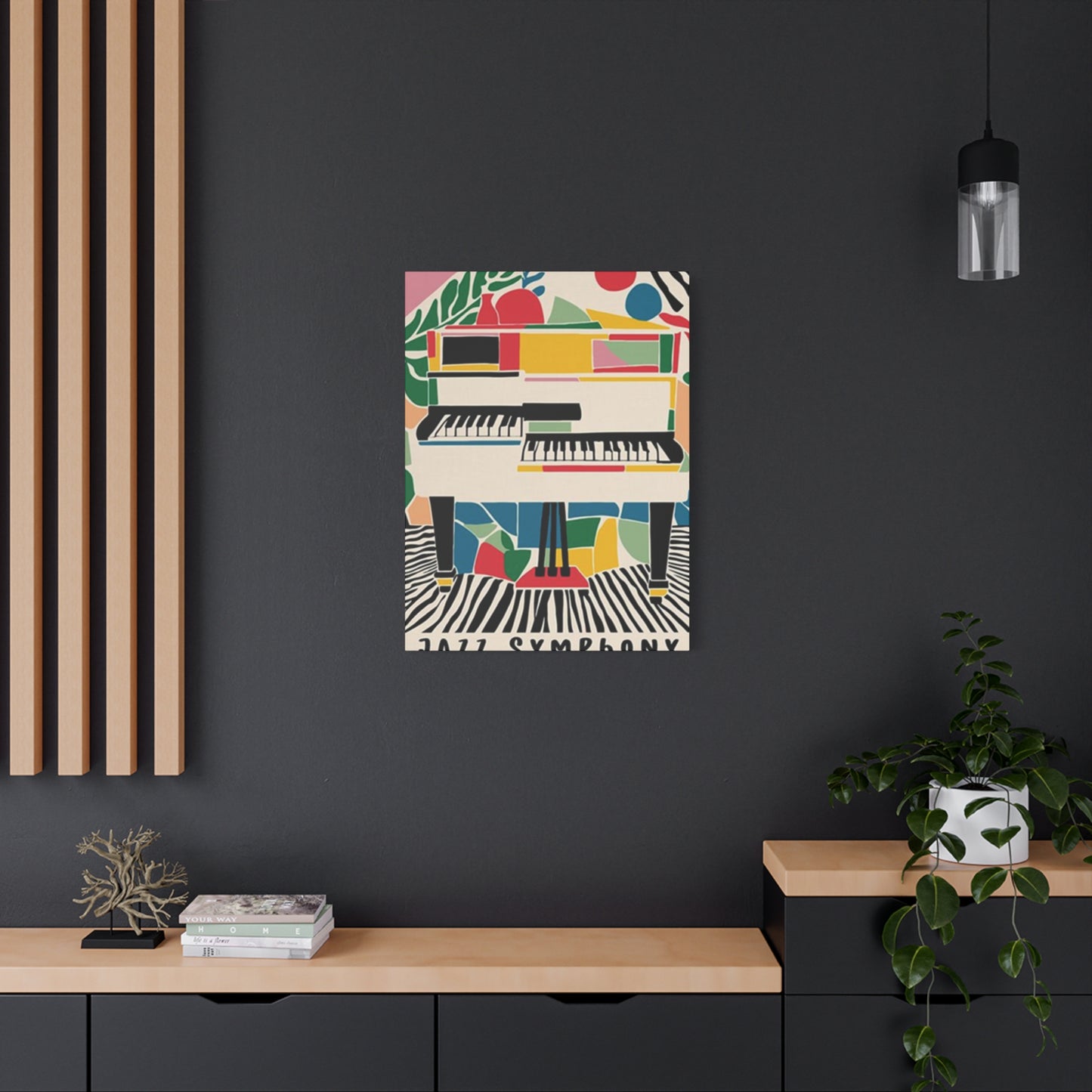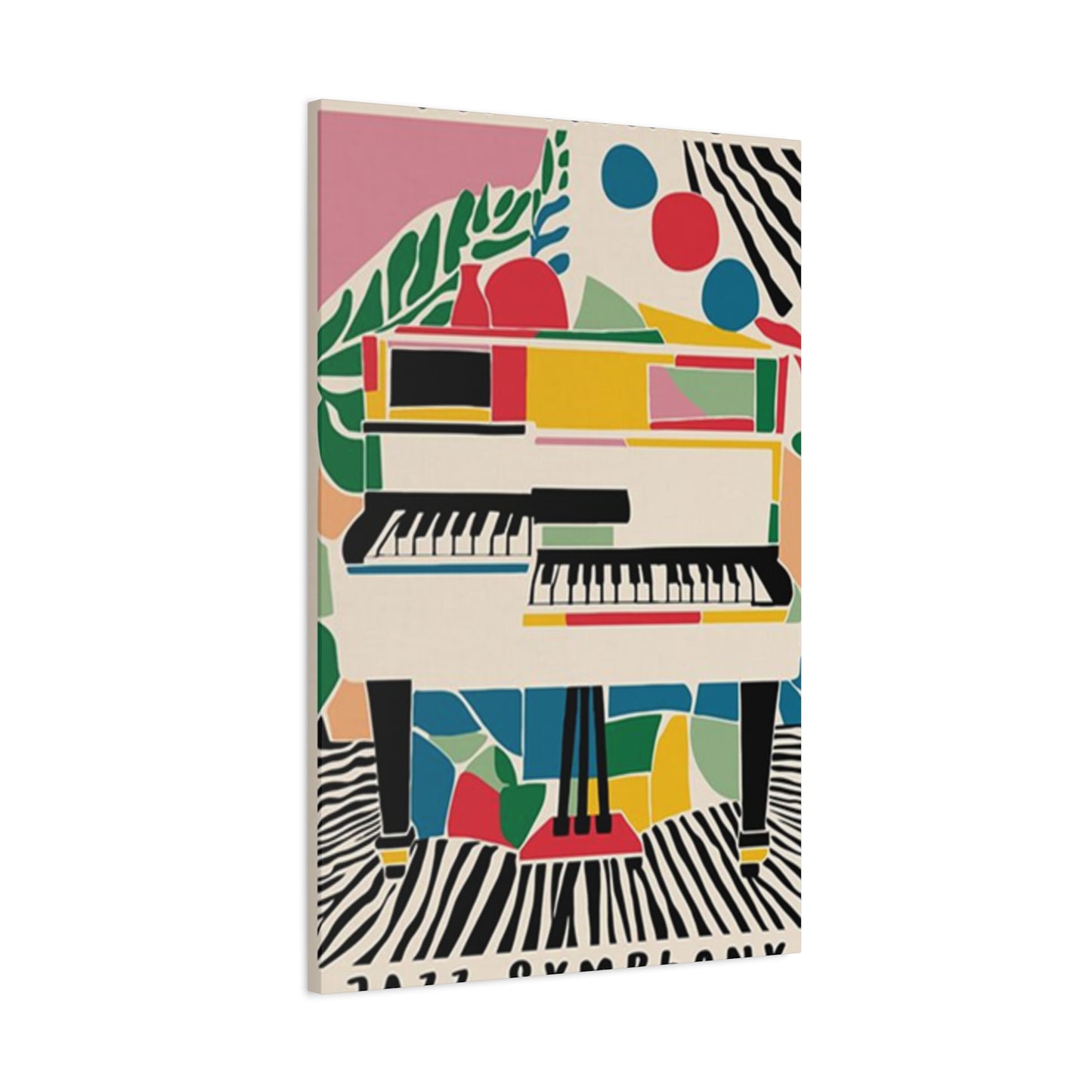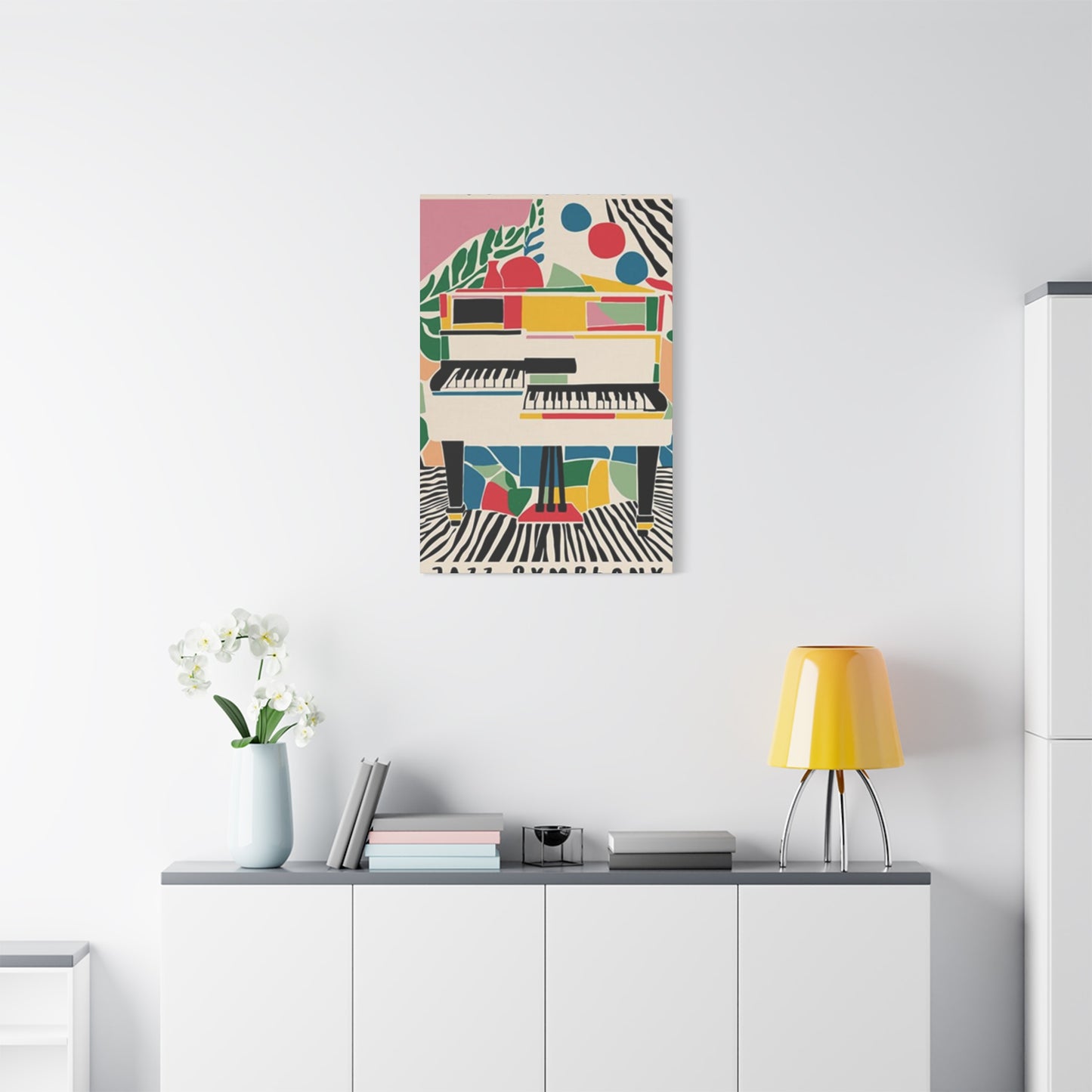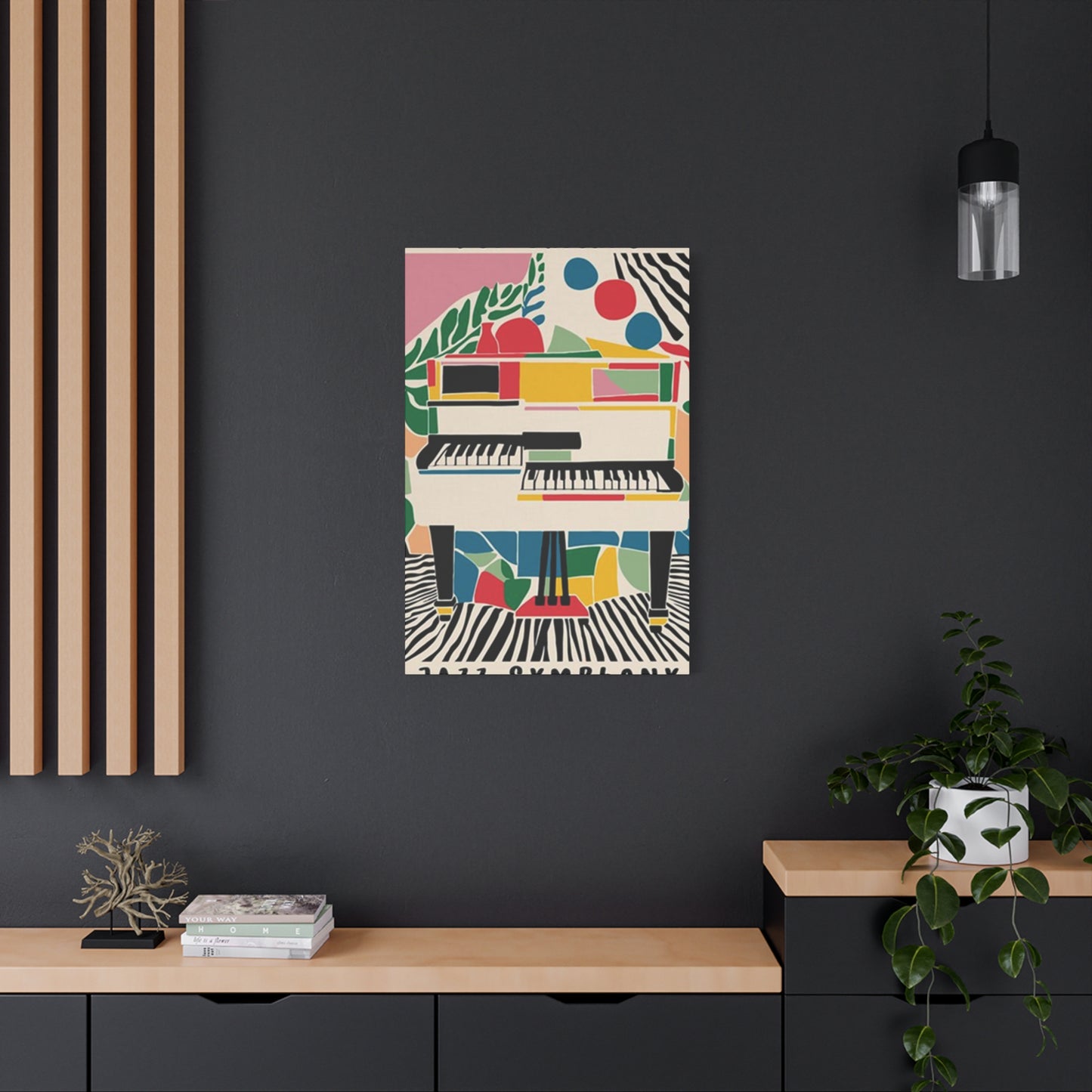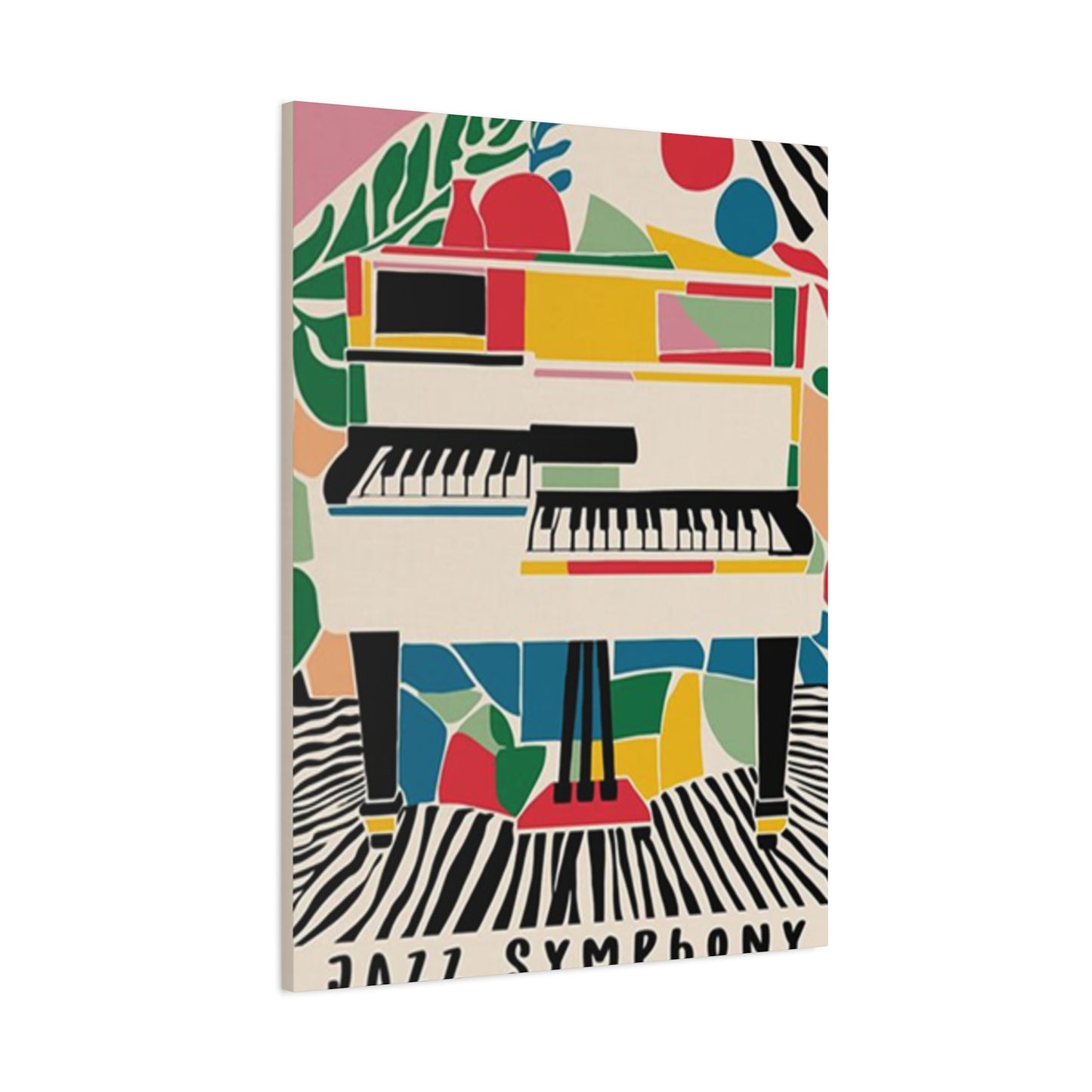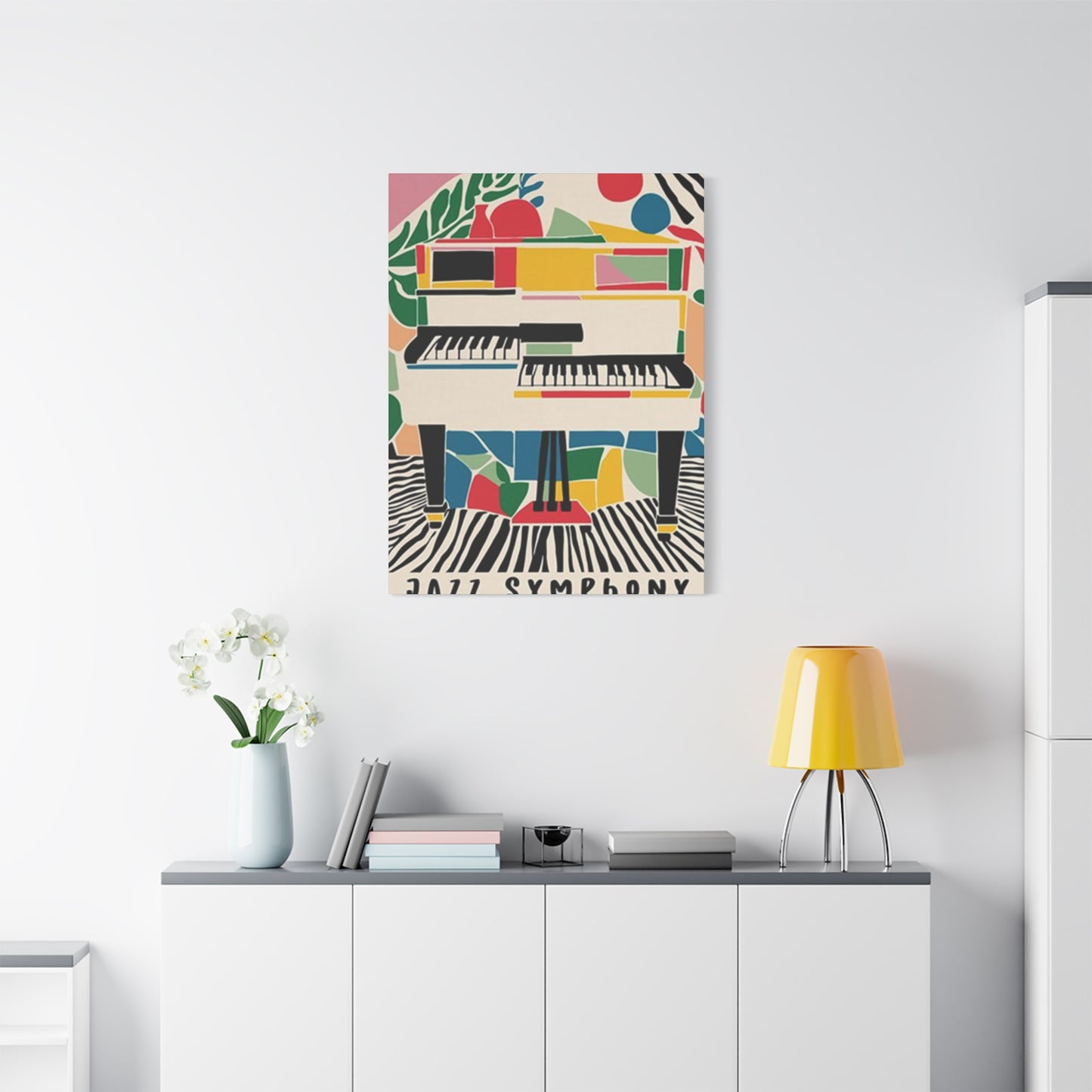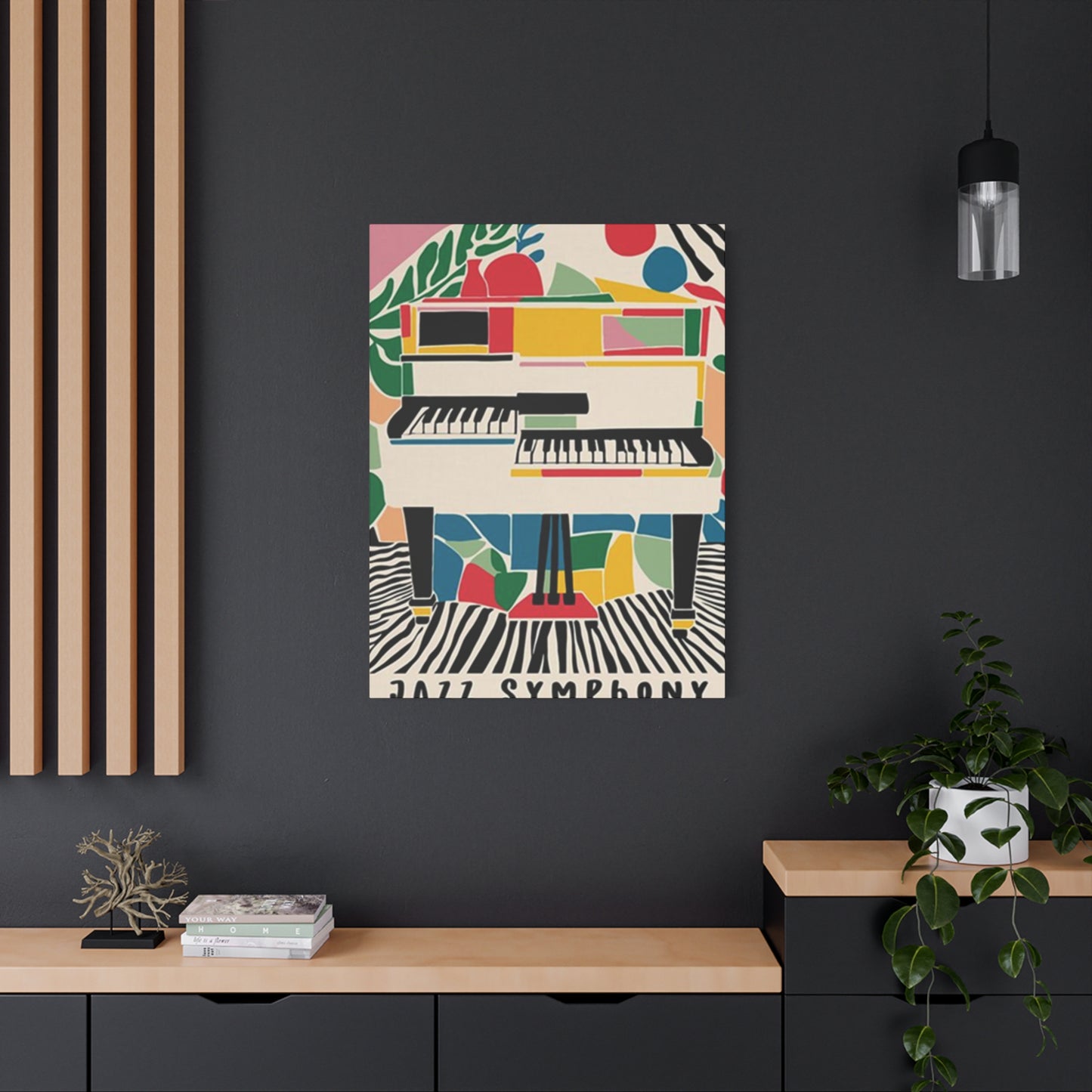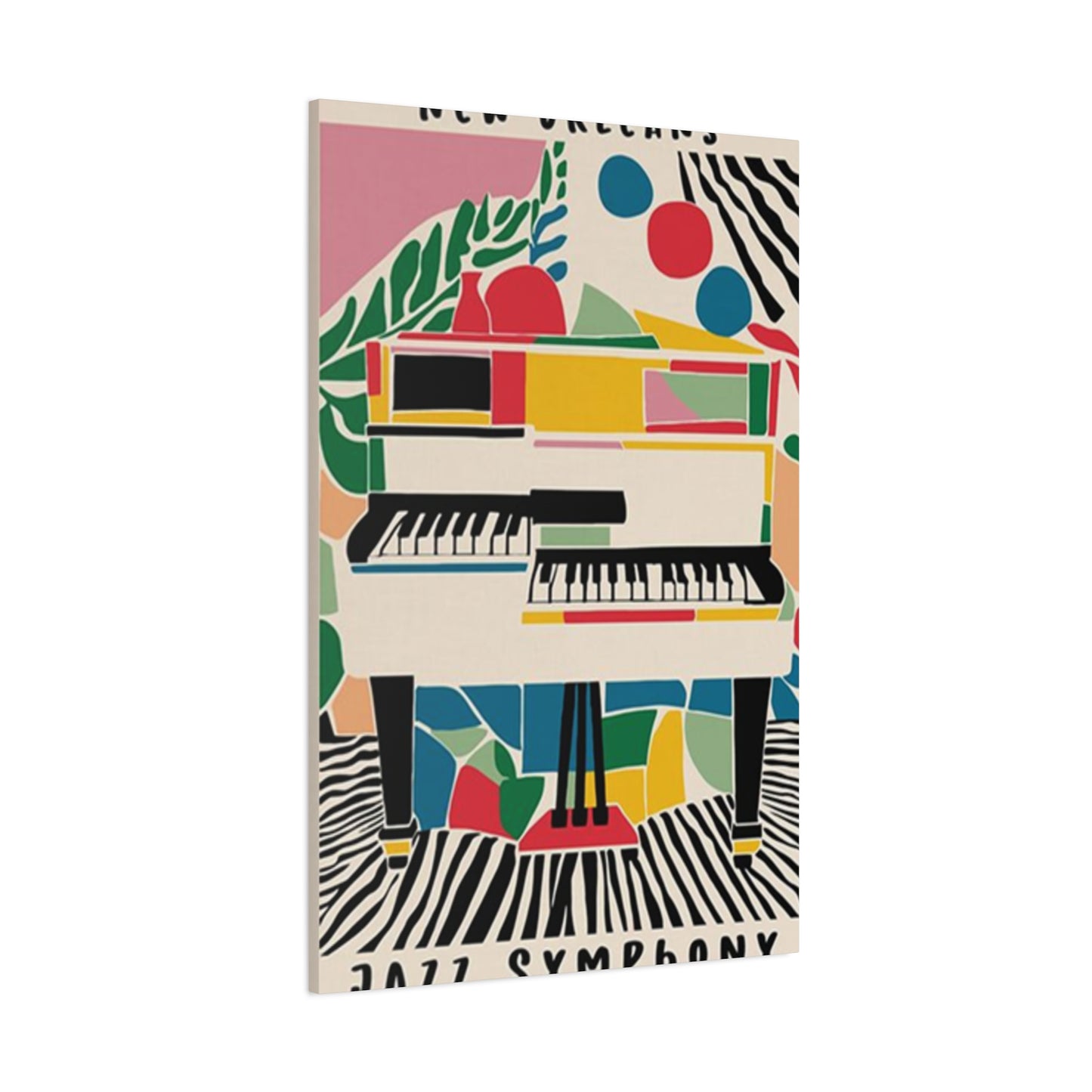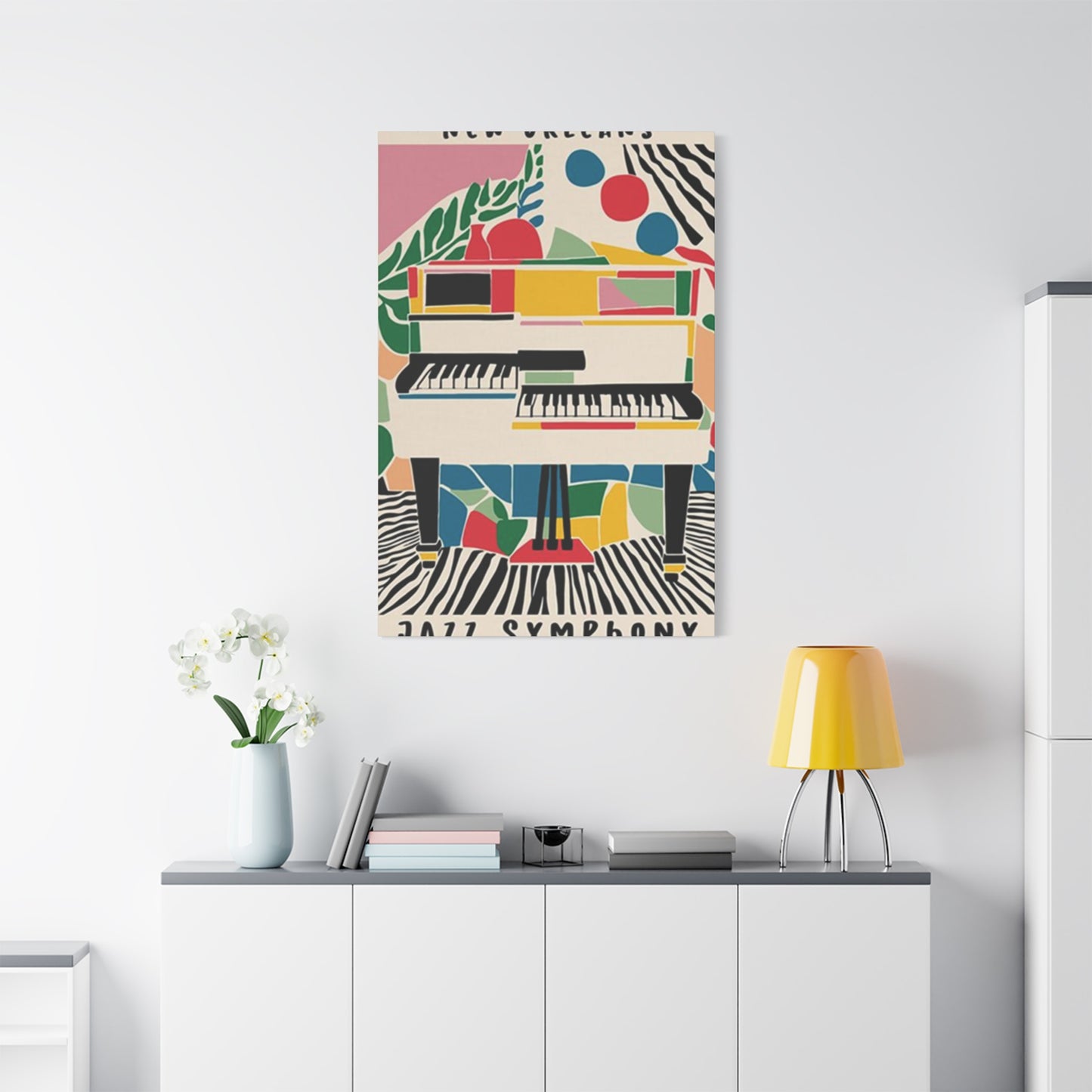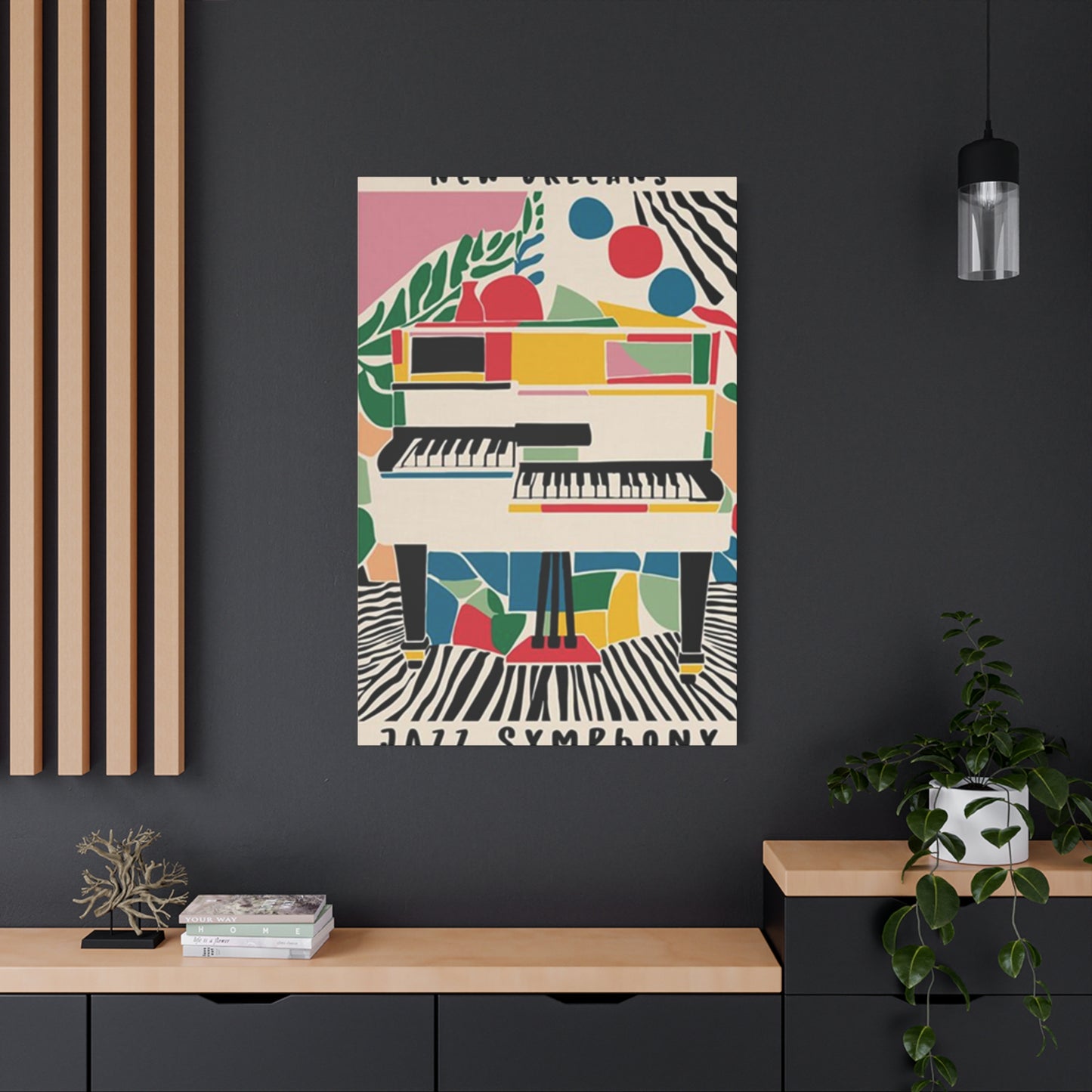Rhythmic Canvases: The Evocative World of Jazz Symphony Wall Art
The confluence of jazz and symphony is a realm of profound emotional depth and complex auditory texture. It's where the structured grandeur of the orchestra meets the improvisational soul of the jazz combo. Capturing this intricate fusion in a visual medium is a unique artistic challenge, one that results in stunning pieces of wall art that resonate with the same energy and elegance as the music itself. This art form isn't merely about depicting musicians or instruments; it's about translating sound into sight, rhythm into line, and harmony into color. It allows us to experience the soaring highs of a trumpet solo and the rich, foundational hum of a cello section through the artist's eye.
Each canvas becomes a silent performance, a frozen moment of musical brilliance that can fill a room with the spirit of a concert hall. Exploring the various artistic interpretations of the jazz symphony provides a deeper appreciation for how painters and printmakers alike grapple with the intangible, turning fleeting notes into enduring visual statements that celebrate one of music's most dynamic and sophisticated genres. This exploration reveals a world where visual art and music are not separate entities, but two languages expressing the same universal emotions.
The Intersection of Jazz and Visual Art
Jazz and visual art have shared a profound and enduring relationship, one deeply rooted in the mutual principles of expression, spontaneity, and innovation. Both art forms thrive on pushing boundaries—whether it’s through the improvisational nature of a jazz solo or the intuitive brushstrokes of a painter capturing a fleeting moment of emotion. At their core, jazz and visual art seek to convey complex emotions and stories without relying solely on literal representation, instead inviting the audience into an experience that feels both personal and universal.
The world of jazz, with its syncopated rhythms, layered harmonies, and ever-changing tempo, offers a rich source of inspiration for visual artists. Just as a jazz musician crafts intricate soundscapes by weaving together unexpected notes and rhythms, artists translate these auditory experiences into visual narratives. This translation often manifests as abstract compositions where brushstrokes mimic the fluidity of a saxophone’s melody or where splashes of color evoke the energetic beat of drums. These works become what many refer to as “rhythmic canvases”—artworks that embody the rhythm, pulse, and spontaneity of jazz symphonies.
Rhythmic canvases go beyond mere decoration; they serve as visual interpretations of jazz’s intangible qualities. The energetic motion of a trumpet solo might be reflected in sweeping lines and bold color contrasts, while the subtle nuance of a bass line can be expressed through deep, grounding tones and textures. By blending the auditory and visual, these artworks create an immersive experience that transcends traditional sensory boundaries.
This fusion also highlights the shared cultural heritage of jazz and modern visual art, both born from moments of social transformation and artistic experimentation. Jazz symphony wall art, in particular, invites viewers to engage with the music on a different plane—transforming a room into a vibrant homage to creativity and improvisation. Whether in homes, galleries, or public spaces, rhythmic canvases celebrate the spirit of jazz by capturing its energy and soul on walls, creating a powerful dialogue between sight and sound.
In essence, the relationship between jazz and visual art is a testament to the boundless possibilities when different forms of creativity intersect. Through rhythmic canvases, audiences are offered not just a glimpse but a deeply evocative experience of jazz, one that continues to inspire artists and admirers alike.
Origins and Evolution of Jazz Symphony Wall Art
The idea of translating music into visual art is far from new; it has been an enduring pursuit that spans centuries, but it gained particular momentum in the early 20th century with the emergence of synesthesia as a compelling artistic concept. Synesthesia refers to a fascinating cross-sensory phenomenon where stimulation of one sense involuntarily triggers the experience of another—for example, hearing music might evoke the perception of colors or shapes. Pioneering artists like Wassily Kandinsky explored this phenomenon extensively, believing that colors and abstract forms could visually express the intangible qualities of sound.
His abstract paintings, filled with dynamic shapes and vibrant hues, were heavily influenced by the improvisational freedom and intricate rhythms of jazz music, which was burgeoning during his time. Kandinsky sought to capture the emotional intensity of music on canvas, translating the improvisational spirit of jazz into visual symphonies that pulsed with life and motion.The relationship between jazz and visual art deepened during the Harlem Renaissance and the Jazz Age of the 1920s and 1930s—a vibrant cultural movement that celebrated African American art, music, and literature.
During this era, jazz was not merely a genre of music; it became a powerful cultural phenomenon symbolizing modernity, resilience, and creative expression. Artists like Romare Bearden and Archibald Motley became pivotal in shaping jazz’s visual identity through their evocative portrayals of musicians, nightlife, and the urban atmosphere that surrounded jazz culture. Their paintings often depicted smoky clubs, lively dance floors, and charismatic performers, bringing the energy and spirit of the music scene to life on canvas.
These works did more than illustrate—they chronicled a cultural moment and helped define how jazz was visually experienced by audiences, influencing countless artists who followed.In the contemporary art world, jazz symphony wall art has evolved into a distinct, highly expressive genre. Today’s artists are not limited to traditional painting techniques but embrace a multidisciplinary approach, incorporating digital art, photography, and mixed media to craft what are known as rhythmic canvases.
These artworks go beyond straightforward depictions of musicians or instruments. Instead, they strive to embody the very essence of jazz—its improvisational pulse, emotional depth, and fluid movement—through abstract forms, color theory, and dynamic compositions. Modern jazz symphony art invites viewers to feel the music visually, allowing color gradients to mimic the ebb and flow of melodies, while bold shapes reflect the syncopated rhythms and harmonies that define jazz. This innovative blending of mediums creates immersive experiences that honor jazz’s timeless energy and its ongoing influence across artistic disciplines.
The Visual Melody of Flowing Notes in Artistic Prints
Translating the ephemeral nature of musical notes into a tangible, visual form is a central endeavor in artwork inspired by the jazz symphony. Artists who tackle this subject are not just painting musicians; they are attempting to paint the music itself. In these prints, musical notes are rarely depicted as static symbols on a staff. Instead, they are reimagined as dynamic, flowing elements that dance across the canvas, visually embodying the tempo and mood of a composition. You might see elegant, calligraphic swirls of color that represent a lyrical saxophone melody, each curve and sweep suggesting the smooth, connected notes of a legato phrase. In other works, sharp, staccato rhythms are conveyed through a series of short, energetic dashes or points of light, mimicking the punchy attack of a brass section or the percussive strike of a piano key.
The choice of color is paramount in this visual translation. An artist might use deep, resonant blues and purples to represent the rich, melancholic tones of a cello or a double bass, while the fiery, brilliant sound of a trumpet solo could be visualized through explosive bursts of orange, red, and gold. These abstract representations invite the viewer to not just see the art, but to almost hear it, creating a synesthetic experience where the lines and colors trigger an auditory memory or sensation. The composition of these flowing forms guides the eye through the piece in the same way a melody guides the ear, creating a sense of progression, climax, and resolution within the static frame of the artwork.
Capturing the Collective Spirit of Jazz Symphony Ensembles
While some artworks focus on the abstract nature of music, others celebrate the human element at its core: the ensemble. Depictions of entire jazz symphony orchestras on canvas are a powerful tribute to the collaborative spirit of this musical genre. These pieces capture the intricate interplay between dozens of musicians, transforming a moment of performance into an enduring tableau of collective creation. The artist's challenge is to create a composition that feels both unified and detailed, showcasing the orchestra as a single, powerful entity while still allowing the individuality of different sections to emerge. The arrangement of figures is crucial. A painter might use a wide, panoramic perspective to emphasize the scale and grandeur of the full orchestra, with the conductor at the heart of the scene, a focal point of energy directing the flow of sound.
The lighting often plays a theatrical role, with dramatic spotlights isolating a soloing musician or casting long, evocative shadows that add depth and mystery to the scene. The body language of the musicians is another key detail; the intense concentration of the string section, the relaxed yet focused posture of the jazz pianist, the exuberant energy of the percussionist—all these small narratives contribute to the overall story of the performance. These artworks are more than just group portraits; they are dynamic scenes filled with a sense of anticipation and shared purpose. They celebrate the beautiful complexity of numerous individual talents merging to create a single, harmonious, and overwhelmingly powerful auditory experience, all captured silently on canvas
Dynamic Brushwork as a Visual Echo of Rhythmic Vitality
The technique an artist employs is as important as the subject matter when conveying the spirit of a jazz symphony. The use of bold, expressive brushstrokes is a particularly effective method for translating the genre's rhythmic complexities and emotional power onto the canvas. This is not about smooth, photorealistic rendering; it is about conveying feeling and movement through the very texture and application of the paint. A thick, impasto technique, where paint is laid on so thickly that it stands out from the surface, can perfectly mirror the percussive, heavily textured sound of a syncopated jazz rhythm. Each visible stroke becomes the visual equivalent of a musical beat, a tangible mark of the artist's energetic engagement with the subject. You can almost feel the driving force of a walking bassline or the explosive crash of a cymbal in the swift, decisive application of paint.
Conversely, an artist might use long, sweeping brushstrokes to represent the sustained, soaring notes of a symphonic string arrangement that swells behind a jazz soloist. The contrast between these different types of brushwork within a single painting creates a visual tension and harmony that directly reflects the fusion of jazz and classical elements in the music. The direction of the strokes can guide the viewer's eye, creating a sense of rushing movement or calm stability. This approach makes the artist's hand an integral part of the experience, their physical gestures becoming a permanent part of the artwork, echoing the physical act of making music.
Moody Atmospheres of Nocturnal Symphony Performances
The quintessential image of jazz is often set in the low, warm light of a club after dark, and this atmospheric quality is a powerful theme in wall art depicting jazz symphony performances. These nighttime scenes are rich with mood, emotion, and a sense of sophisticated intimacy. Artists utilize a palette dominated by deep, resonant colors—midnight blues, velvety blacks, and rich indigos—to create a backdrop of nocturnal elegance. Against this darkness, the warm, artificial light of the stage becomes a crucial compositional element. The golden glow reflecting off the bell of a saxophone, the soft yellow light pooling on the keys of a grand piano, or the stark white illumination of the conductor's stand creates points of focus and drama.
The technique of chiaroscuro, the strong contrast between light and shadow, is frequently employed to sculpt the forms of the musicians and their instruments, adding a three-dimensional quality and a sense of mystery. Shadows can suggest the presence of an unseen audience or add to the cavernous feeling of a grand concert hall. These paintings are not just about the music; they are about the entire environment in which the music is born. They evoke the feeling of being present at a late-night performance, where the outside world fades away and the only thing that matters is the shared experience of sound and emotion. The nocturnal setting enhances the sense of focus on the performers, making them luminous figures in a darkened world, their art the only source of light.
The Symphony of Texture in Mixed-Media Compositions
Beyond the texture created by brushstrokes, many artists explore a more literal layering of materials to capture the dense, multi-faceted nature of jazz symphony music. This approach, often involving mixed media, allows for a richness and depth that a single medium might not achieve. A painting can be more than just paint on canvas; it can be a complex surface that engages both sight and touch, mirroring the way a jazz symphony engages the ear with its multiple layers of instrumentation and harmony. An artist might incorporate elements of collage, using snippets of sheet music, old concert posters, or textured papers to build up the background of a piece.
These embedded fragments add historical and thematic context, grounding the artwork in the culture of the music it represents. Gels and glazes can be applied over acrylic or oil paints to create areas of high gloss that contrast with matte finishes, mimicking the way a single instrument’s sound can shine through the broader texture of the orchestra. Some artists even use metallic powders or foils to catch the light, suggesting the brilliant flash of brass instruments.
This physical layering on the canvas is a direct visual metaphor for the compositional layering in the music. Just as a composer arranges the strings, brass, woodwinds, and a jazz rhythm section into a complex yet cohesive whole, the artist builds up the surface of the painting, with each textural element contributing to the final, unified composition. The result is a piece of wall art that is not just a representation of music, but a textured object that embodies its complexity.
Celebrating the Virtuoso: The Soloist in Symphonic Context
Within the grand tapestry of a jazz symphony, the moment of the solo is one of profound focus and individual expression. Wall art that hones in on this dynamic captures the intimate relationship between a musician and their instrument, set against the powerful backdrop of the full orchestra. These pieces often feature a single figure—a trumpeter, a pianist, a saxophonist—as the undeniable focal point. The artist's goal is to convey the intense concentration and emotional release of the performance. This is achieved through meticulous attention to detail in the soloist's posture and expression. You might see the closed eyes of a saxophonist, completely lost in the melody they are creating, or the taut muscles in a trumpeter's cheeks as they reach for a high note.
The lighting in these compositions is often dramatic, with a single, bright spotlight illuminating the soloist, causing them to stand out vividly from the more subtly lit orchestra behind them. The symphonic setting is not just a passive background; it is an active part of the narrative. It can be rendered in softer focus or with more muted colors to emphasize the prominence of the solo, yet its presence provides a sense of scale and context. This visual contrast highlights the beautiful tension in a jazz symphony: the dialogue between the singular, improvisational voice of the jazz musician and the structured, collective power of the classical orchestra. These artworks are a tribute to virtuosity and the courage of individual expression within a larger, collaborative framework.
An Ode to Form: Portraying Classic Instruments in Art
Sometimes, the most compelling subject in music-inspired art is not the musician, but the instrument itself. Artworks that feature classic instruments from the jazz and symphonic traditions are a celebration of form, craftsmanship, and potential energy. These pieces treat the instruments as objects of sculptural beauty, their elegant curves, polished surfaces, and intricate mechanics becoming the central focus of the composition.
A painting might be a detailed, almost reverent, study of a cello leaning against a chair, the warm light catching the rich grain of the wood. Another piece could focus on the complex and beautiful tangle of keys and valves on a saxophone, rendered with such precision that you can almost feel the cool metal. The interplay of light and reflection is a key theme in these works. The brilliant sheen of a polished brass trumpet, the glossy black expanse of a grand piano, or the subtle luster of a violin's varnish are all opportunities for the artist to showcase their skill in rendering light and texture.
These compositions are often quiet and contemplative, unlike the energetic scenes of live performance. They capture the instrument at rest, a silent vessel full of latent musicality. By removing the musician, the artwork invites the viewer to consider the instrument on its own terms, to appreciate its design and to imagine the incredible sounds it is capable of producing. It is an ode to the tools of the trade, the beautiful, masterfully crafted objects that allow human emotion to be transformed into the universal language of music.
Exploring Lyrical Moods with Soft Pastel Color Palettes
While much of jazz symphony art is characterized by bold colors and dramatic contrasts, a significant subset explores the softer, more lyrical side of the genre through the use of pastel tones. This approach is perfectly suited to capturing the mood of a gentle ballad, a cool jazz composition, or a piece where the lush, romantic sweep of the symphonic strings takes precedence. Instead of the dynamic energy of primary colors, these artworks are bathed in a gentler light, using a palette of soft pinks, dusty blues, pale yellows, and muted lavenders. These colors evoke a sense of calm, nostalgia, and introspection.
A print might depict a lone pianist at a keyboard, the scene rendered in subtle, hazy tones that suggest a dream or a memory. Another might use washes of light, transparent color to create an abstract representation of a smooth, flowing melody, where the different instrumental voices blend seamlessly into one another. This color choice significantly affects the emotional impact of the artwork, shifting it from exuberant and energetic to contemplative and serene.
It highlights the often-overlooked subtlety and tenderness present in the jazz symphony repertoire. These pieces do not shout; they whisper. They create a soothing and elegant atmosphere, inviting quiet reflection and providing a visual respite that is as calming to the eye as a beautiful, slow melody is to the ear. This style demonstrates the incredible versatility of the genre as an artistic inspiration, capable of producing works of both fiery passion and gentle grace.
Visualizing Velocity: The Essence of Movement in Jazz Art
Music, by its very nature, is an art of movement and time. A significant challenge for a visual artist is to capture this inherent dynamism within the confines of a static, two-dimensional surface. Artwork that successfully conveys the energetic movement of a jazz symphony performance is particularly compelling, making the canvas vibrate with implied sound and motion. Artists employ various techniques to achieve this effect. Gestural abstraction is a powerful tool, where a flurry of rapid, sweeping lines and energetic splashes of color can suggest the frenetic energy of an up-tempo piece or a complex improvisational solo.
The figures of the musicians themselves can be rendered with a sense of motion blur, their outlines softened and trailing as if captured in a long-exposure photograph. This technique brilliantly conveys the physicality of the performance—the quick, nimble movement of a drummer's arms, the sway of a bassist, or the energetic gestures of a conductor shaping the music in the air.
The composition can also be designed to create a sense of momentum, using strong diagonal lines and asymmetrical arrangements that lead the eye on a dynamic path across the artwork, preventing it from feeling static. The goal is to make the viewer feel the rhythm, not just see its depiction. Successful pieces in this style are alive with a kinetic energy that seems barely contained by the frame, offering a powerful visual metaphor for the unstoppable, forward-driving pulse that is the very heart of jazz.
Iconic Album Aesthetics Reimagined for Wall Decoration
The visual identity of jazz has been profoundly shaped by its rich history of iconic album cover design. The bold typography, striking photography, and minimalist graphic sensibilities of labels like Blue Note created a visual language that was as cool and sophisticated as the music itself. A fascinating genre of wall art draws inspiration from this legacy, reimagining the aesthetic of classic jazz symphony album covers as large-scale artistic statements. These pieces are not mere reproductions; they are creative reinterpretations that expand upon the original design concepts. An artist might take the simple, two-tone color palette and graphic shapes of a vintage album and develop it into a large, abstract painting, exploring the interplay of those forms on a much grander scale.
Another work might isolate a single element from a classic cover—the stylized silhouette of a musician, for instance—and render it using rich, textured paints, transforming a piece of graphic design into a work of fine art. This approach celebrates the deep connection between the auditory and visual branding of the music. It pays homage to the designers who helped define the public image of jazz, while simultaneously creating something new and suitable for a contemporary setting. These artworks possess a built-in sense of style and historical resonance, appealing to both music lovers and those with an appreciation for mid-century graphic design. They serve as a sophisticated nod to music history, transforming the ephemeral packaging of a record into an enduring piece of visual culture for the home.
The Artistic Synthesis of Classical and Jazz Traditions
The very term "jazz symphony" describes a fusion, a deliberate blending of two distinct musical worlds. Wall art that directly addresses this synthesis offers some of the most intellectually and aesthetically engaging interpretations of the genre. These artworks are not just about jazz or classical music; they are about the exciting, often unexpected, space where they meet. Visually, this fusion can be represented in numerous ways. A composition might literally place jazz musicians within a traditionally classical setting, such as a gilded, ornate concert hall, highlighting the contrast and dialogue between the two traditions.
The style of the artwork itself can reflect this blend. An artist might combine highly structured, geometric patterns reminiscent of classical form and order with free-flowing, improvisational, and organic shapes that represent the spirit of jazz. The color palette could also be divided, with one part of the canvas dominated by the sober, traditional colors of the symphony and another exploding with the vibrant, unconventional hues of jazz, with a dynamic area of overlap where these colors mix and merge.
These pieces are often conceptual, asking the viewer to think about the nature of musical genres, tradition, and innovation. They are a visual representation of a cultural conversation, celebrating the moment when the disciplined structure of the orchestra embraced the liberating spirit of improvisation, creating a sound that was entirely new and thrillingly complex. This art is for the deep listener, the aficionado who appreciates the rich history and bold experimentation that define the jazz symphony.
The Timeless Elegance of Black and Gold Symphonic Themes
There is a particular color combination that perfectly captures the sophisticated, luxurious, and dramatic essence of a jazz symphony performance: black and gold. This timeless pairing has become a prominent theme in wall art inspired by the genre, offering a sense of elegance and high-impact visual appeal. The symbolism is potent and direct. Black represents the quintessential nighttime setting of the performance—the darkened concert hall, the sharp formality of the musicians' attire, the deep, resonant tones of the lower register instruments. It provides a dramatic and powerful backdrop that allows the highlights to truly shine.
Gold, in turn, embodies the music's brilliance and value. It is the color of polished brass instruments—trumpets, trombones, saxophones—gleaming under the stage lights. It represents the "golden tones" of a virtuoso performer and the magical, high-energy moments of a musical crescendo. Artists often use metallic gold paint or even gold leaf in these pieces, which adds a dynamic quality to the work.
As the ambient light in a room changes throughout the day, the gold elements catch it differently, causing the artwork to subtly shift and shimmer, imbuing it with a life and energy that flat colors cannot match. A canvas might feature a stark black silhouette of a jazz ensemble, with the instruments picked out in brilliant, textured gold. Another might be an abstract piece, with bold, calligraphic strokes of gold sweeping across a deep black field, suggesting both elegance and untamed energy. This color scheme creates an immediate sense of drama and refinement.
Visualizing the Climax: Painting Emotional Crescendos
One of the most thrilling moments in any jazz symphony is the crescendo—that gradual build-up of intensity, volume, and emotional weight that culminates in a powerful, breathtaking climax. Capturing this purely auditory and emotional experience in a static visual medium is an immense artistic challenge, and works that succeed are incredibly powerful. An artist cannot simply paint something "loud"; they must use color, form, and composition to evoke the feeling of rising tension and ultimate release.
Color is often the primary tool. A crescendo might be represented by a gradual shift in the palette, starting with cool, calm colors at one end of the canvas that slowly warm up and intensify, finally erupting into a concentrated area of brilliant, fiery reds, oranges, and yellows at the piece's focal point. Brushwork also plays a critical role. The painting might begin with smooth, controlled strokes that become progressively more energetic, chaotic, and thickly applied as they approach the visual climax.
Compositionally, an artist can create a sense of building pressure by having forms and lines converge towards a single point, drawing the viewer's eye and creating a sense of inevitable and explosive release. This focal point might be an abstract burst of light or a depiction of a soloist at the peak of their performance, their entire posture radiating energy. These paintings are not just snapshots; they are narratives of emotional and auditory journeys. They allow the viewer to experience the most powerful moment of a musical piece, frozen in time
The Narrative Arc: Storytelling in Jazz Performance Art
Beyond capturing a single moment or mood, some of the most ambitious jazz symphony wall art aims to tell a story, conveying the entire narrative arc of a performance within a single visual frame or a series of related pieces. This approach treats a musical composition as a journey with a beginning, a middle, and an end, and it uses visual language to guide the viewer through that progression. A single, large-scale painting might use its composition to create this narrative flow. The left side of the canvas could be rendered in quiet, simple forms and muted colors, suggesting the gentle introduction of a theme.
As the eye travels across the piece, the composition might grow more complex, with more figures, bolder colors, and more dynamic lines introduced, representing the development of the music, the introduction of solos, and the building intensity. The piece might reach a visual climax near the center or right side before resolving into a calmer, more serene passage at the end. Another powerful storytelling device is the use of a diptych (two panels) or triptych (three panels). Each panel can represent a different movement or section of the performance.
The first might depict the quiet anticipation before the music begins, the second the explosive energy of the main theme, and the third the emotional resonance of the final, fading notes. This narrative approach adds a layer of intellectual depth to the artwork, inviting the viewer to spend more time with the piece, to decipher its visual syntax, and to relate it to their own experience of listening to a complex musical work unfold over time.
Conclusion
The visual translation of the jazz symphony into compelling wall art is a testament to the profound and enduring connection between the auditory and visual arts. It is a field rich with diversity, offering a vast spectrum of interpretations that cater to nearly any aesthetic sensibility. From the abstract, synesthetic swirls of color that seek to paint sound itself, to the dynamic, atmospheric depictions of live performances, each artwork offers a unique window into the soul of the music. We have journeyed through canvases that celebrate the collective power of the ensemble and those that isolate the intense, personal moment of a virtuoso's solo.
We have seen how the very application of paint—the bold, textured brushstroke or the soft, layered glaze—can serve as a direct visual metaphor for the rhythmic and harmonic complexities of the music. The choice of palette, whether the dramatic and sophisticated pairing of black and gold, the moody and evocative tones of a nocturnal scene, or the gentle, lyrical hues of pastel, fundamentally shapes the emotional atmosphere of a piece, proving that color can be as expressive as a musical chord.
Furthermore, this art form does more than simply decorate a room; it infuses it with a story and a spirit. It captures the kinetic energy of performance, the sculptural beauty of the instruments, and the emotional crescendo of a musical climax. By reimagining the iconic aesthetics of album covers or by visually deconstructing the fusion of classical and jazz elements, these artworks engage the viewer on an intellectual level, prompting a deeper appreciation for the genre's rich cultural history and innovative spirit. They function as silent storytellers, their compositions guiding the eye through a narrative arc that mirrors the progression of a musical piece.
To bring a piece of jazz symphony wall art into one’s environment is to make a statement about a love for sophistication, for emotional depth, and for the thrilling point of creation where structure meets improvisation. It is a way to keep the spirit of a live performance eternally present, to capture a fleeting moment of auditory brilliance and give it a permanent, tangible form. This art stands as a powerful reminder that music does not have to be heard to be felt, and that its energy, passion, and elegance can resonate powerfully from a canvas, continually enriching our surroundings with its silent, beautiful rhythm.

















